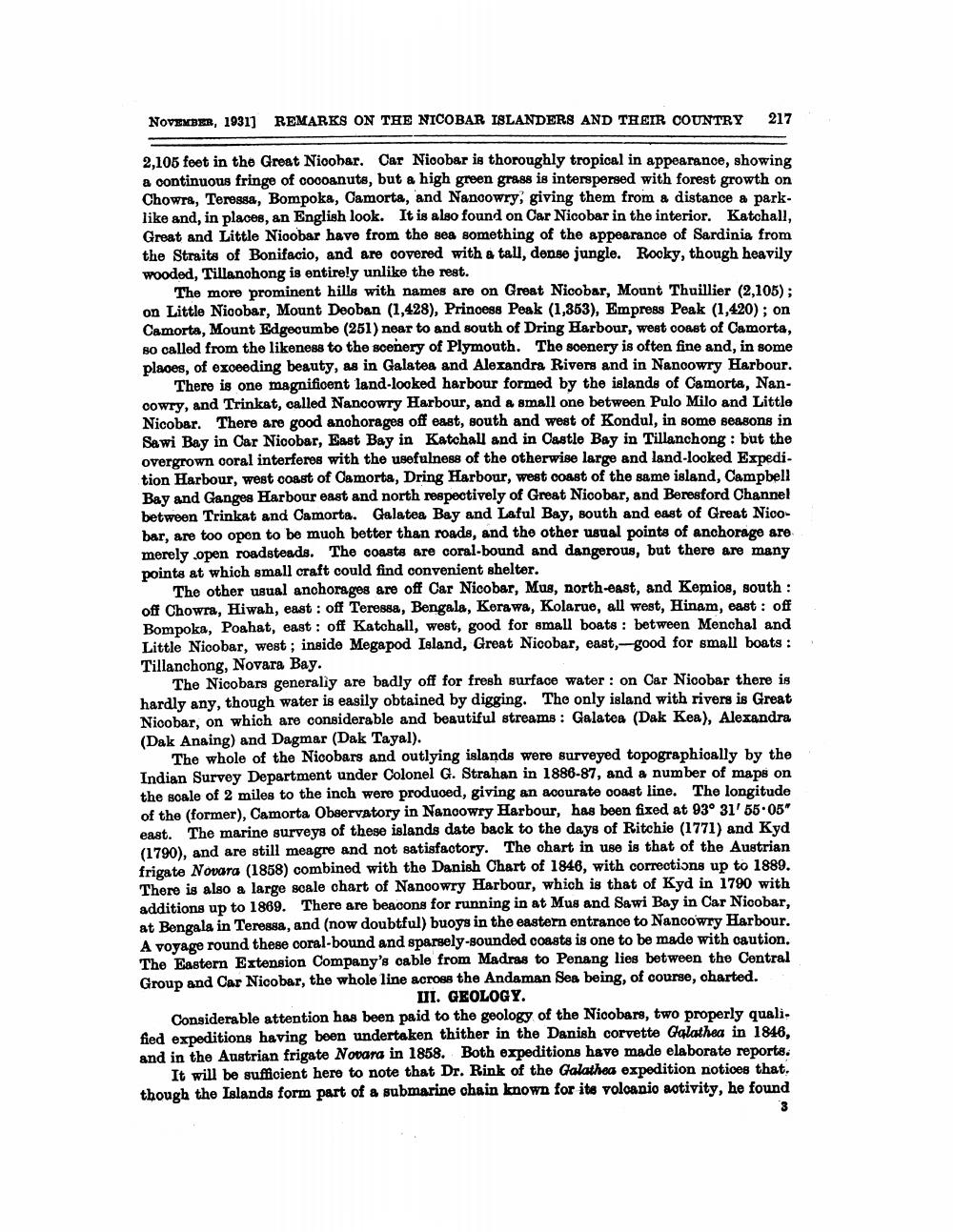________________
NOVEMBER, 1931] REMARKS ON THE NICOBAR ISLANDERS AND THEIR COUNTRY 217
2,105 feet in the Great Nicobar. Car Nicobar is thoroughly tropical in appearance, showing a continuous fringe of cocoanuts, but a high green grass is interspersed with forest growth on Chowra, Teressa, Bompoka, Camorta, and Nancowry, giving them from a distance a parklike and, in places, an English look. It is also found on Car Nicobar in the interior. Katchall, Great and Little Nioobar have from the sea something of the appearance of Sardinia from the Straits of Bonifacio, and are covered with a tall, dense jungle. Rocky, though heavily wooded, Tillanohong is entirely unlike the rest.
The more prominent hills with names are on Great Nicobar, Mount Thuillier (2,105); on Little Nicobar, Mount Deoban (1,428), Princess Peak (1,353), Empress Peak (1,420); on Camorta, Mount Edgecumbe (251) near to and south of Dring Harbour, west coast of Camorta, so called from the likeness to the scenery of Plymouth. The scenery is often fine and, in some places, of exceeding beauty, as in Galatea and Alexandra Rivers and in Nancowry Harbour.
There is one magnificent land-looked harbour formed by the islands of Camorta, Nancowry, and Trinkat, called Nancowry Harbour, and a small one between Pulo Milo and Little Nicobar. There are good anchorages off east, south and west of Kondul, in some seasons in Sawi Bay in Car Nicobar, East Bay in Katchall and in Castle Bay in Tillanchong: but the overgrown coral interferes with the usefulness of the otherwise large and land-locked Expedition Harbour, west coast of Camorta, Dring Harbour, west coast of the same island, Campbell Bay and Ganges Harbour east and north respectively of Great Nicobar, and Beresford Channel between Trinkat and Camorta. Galatea Bay and Laful Bay, south and east of Great Nicobar, are too open to be much better than roads, and the other usual points of anchorage are merely open roadsteads. The coasts are coral-bound and dangerous, but there are many points at which small craft could find convenient shelter.
The other usual anchorages are off Car Nicobar, Mus, north-east, and Kemios, south: off Chowra, Hiwah, east: off Teressa, Bengala, Kerawa, Kolarue, all west, Hinam, east: off Bompoka, Poahat, east: off Katchall, west, good for small boats: between Menchal and Little Nicobar, west; inside Megapod Island, Great Nicobar, east,-good for small boats: Tillanchong, Novara Bay.
The Nicobars generally are badly off for fresh surface water: on Car Nicobar there is hardly any, though water is easily obtained by digging. The only island with rivers is Great Nicobar, on which are considerable and beautiful streams: Galatea (Dak Kea), Alexandra (Dak Anaing) and Dagmar (Dak Tayal).
The whole of the Nicobars and outlying islands were surveyed topographically by the Indian Survey Department under Colonel G. Strahan in 1886-87, and a number of maps on the scale of 2 miles to the inch were produced, giving an accurate coast line. The longitude of the (former), Camorta Observatory in Nancowry Harbour, has been fixed at 93° 31' 55.05" east. The marine surveys of these islands date back to the days of Ritchie (1771) and Kyd (1790), and are still meagre and not satisfactory. The chart in use is that of the Austrian frigate Novara (1858) combined with the Danish Chart of 1846, with corrections up to 1889. There is also a large scale chart of Nancowry Harbour, which is that of Kyd in 1790 with additions up to 1869. There are beacons for running in at Mus and Sawi Bay in Car Nicobar, at Bengala in Teressa, and (now doubtful) buoys in the eastern entrance to Nancowry Harbour. A voyage round these coral-bound and sparsely-sounded coasts is one to be made with caution. The Eastern Extension Company's cable from Madras to Penang lies between the Central Group and Car Nicobar, the whole line across the Andaman Sea being, of course, charted. III. GEOLOGY.
Considerable attention has been paid to the geology of the Nicobars, two properly quali. fied expeditions having been undertaken thither in the Danish corvette Galathea in 1846, and in the Austrian frigate Novara in 1858. Both expeditions have made elaborate reports. It will be sufficient here to note that Dr. Rink of the Galathea expedition notices that. though the Islands form part of a submarine chain known for its volcanic activity, he found
3




